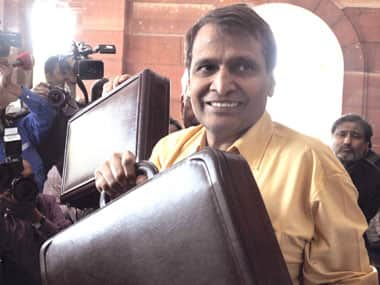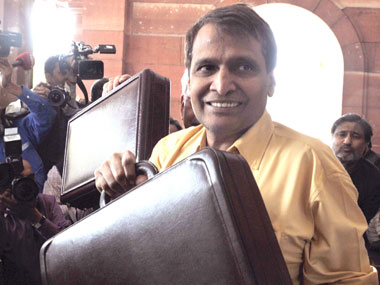The corporate and industries sector sees a lot of positives in the budget presented by Railway Minister Suresh Prabhu. If they have been calling it ‘outstanding’ and ‘reform oriented’, it’s not without reason. Kiran Mazumdar Shaw, CMD of Biocon India Limited, praised Union Rail Minister Suresh Prabhu for “clearly articulating the roadmap he sees in terms of both investment and revenue generation”. “It has been an excellent budget in terms of how the railway minister has used his fiscal innovativeness to come out with a very well thought out and balanced budget. He has very clearly articulated the roadmap that he sees in terms of investments and revenue generation,” she said. [caption id=“attachment_2123089” align=“alignleft” width=“380”]
 Union Railway Minister Suresh Prabhu. Image courtesy PIB[/caption] Indian Railways, she said, has a very important role to play (in terms of logistics) to make the mission of ‘Make in India’ successful. “The outlay the budget has of Rs 8.5 lakh crore is very important because it says how the government is going to tap resources and funds to make it possible,” she added. Although Shaw believes that the minister spelt out the PPP model in details, but she thinks the whole aspect of privatisation also needs to be looked at. “He has not spelt out the actual opportunity for private sector in terms of size and scale. There has not been enough clarity about the kind of investment to be made like line expansion and other infrastructures,” she added. Describing Prabhu’s budget “investment oriented”, Godrej Group chairman and ex-president CII Adi Godrej said that it will “make a difference in Indian Railways in a couple of years. It will prevent the sector from dipping into loans”. Hoping that an increase in plan size of more than Rs 1 lakh crore would have a positive impact on other sectors associated with railways, BEML CMD P Dwarkanath said, “It is good to see that the government has treated this sector as a commercial enterprise, not as a political vehicle.” “The minister has talked about short term and more achievable plans rather than taking up long-term goals. This is an ambitious and aggressive budget,” he told Firstpost. Welcoming proposals like ticket booking portal in different languages, installation of CCTV cameras in ladies compartment, providing Wi-Fi facility on railway stations, improving cleanliness, launching pan-India 24x7 grievances helpline 138 (to be operational from March 1) and not hiking passenger fair, Bibek Debroy, professor at Centre for Policy Research and permanent member of NITI Ayog, said, “Such steps would really help passengers.” “It is a very positive, outstanding and reforms-oriented budget. If the proposed strategies and measures are implemented and executed effectively, Indian Railways will get a prime place in the economy of the country,” JP Chaudhary, chairman of Titagarh Wagons, told Firstpost. Appreciating the idea of making investments through commercial borrowings from insurance and pension funds and tapping low cost long-term funds from bilateral and multi-lateral agencies, Chaudhary said, “It is a very good step to go about it. It will give a boost to the fiscally challenged and cash strapped sector.” However, Prabhu’s budget failed to impress many. Investors are also unhappy because it spared passengers from fare hikes but raised freight rates for coal, cement, others by up to 10 percent. “Freight charge in India is highest in the world and therefore its share of goods transport is rapidly declining. Mr Prabhu perhaps ignored this fact as he raised freight charges for several commodities,” Biswanath Bhattacharya, partner at KPMG Advisory, told Firstpost. The budget put the operating ratio target at 88.5 percent for 2015-16. It means, the railways will save in the coming year 11.5 paise per rupee it earns. But it also failed to impress experts because the savings are likely to come from the hike in freight rates. “If the operating ratio is improved by increasing freight rate and not through innovative schemes, it will not have a lot of impact,” he said. The Merchants Chamber of Commerce said the hike in freight charges will have a bad impact on industrial projects”. It further said there is no clarity on how the government will complete work-in-progress. “The budget speech was nicely written. But there was no roadmap on how he the government is going to achieve the set targets. The minister emphasised on the need of PPP model and other arrangements. But he forgot that it is unlikely to meet targets by depending on others,” it said. Renowned economist Jayati Ghosh, who teaches at Centre for Economic Studies, Jawaharlal Nehru University (JNU), found “nothing significant” in the Railway Budget 2015. “The government is proudly claiming that it did not increase the passenger fair but what about freight rate hikes. It will affect common man as well because it ultimately translates into money,” she said. She accused the government of making insufficient budgetary allocation. “If you study railway budgets across the world where railway ministry is working effectively, you will see the role of government is large. At least 70 per cent of the railway annual budget comes from the government. But what did we see here? We saw that the government budgetary support is only Rs 40,000 crore and the rest around close to Rs 50,000 to 55,000 crore is dependent on the private and external sectors. If you are depending too much on market borrowings and loans, your future generations will have a huge debt burden,” she said adding that “the proposed private venture will support the government in connecting Northeast and Kashmir Valley to the rest of India through rail networks because the monetary benefits will be less in these areas”. Srei Infrastructure Finance CMD Hemant Kanoria said the success of the budget depends on mobilisation of funds. “The plan outlay for capital expenditure has been increased by 52 per cent to Rs 1 lakh crore. It is a positive step. But there was no clear roadmap on how the government will arrange the additional funds,” he said.
Union Railway Minister Suresh Prabhu. Image courtesy PIB[/caption] Indian Railways, she said, has a very important role to play (in terms of logistics) to make the mission of ‘Make in India’ successful. “The outlay the budget has of Rs 8.5 lakh crore is very important because it says how the government is going to tap resources and funds to make it possible,” she added. Although Shaw believes that the minister spelt out the PPP model in details, but she thinks the whole aspect of privatisation also needs to be looked at. “He has not spelt out the actual opportunity for private sector in terms of size and scale. There has not been enough clarity about the kind of investment to be made like line expansion and other infrastructures,” she added. Describing Prabhu’s budget “investment oriented”, Godrej Group chairman and ex-president CII Adi Godrej said that it will “make a difference in Indian Railways in a couple of years. It will prevent the sector from dipping into loans”. Hoping that an increase in plan size of more than Rs 1 lakh crore would have a positive impact on other sectors associated with railways, BEML CMD P Dwarkanath said, “It is good to see that the government has treated this sector as a commercial enterprise, not as a political vehicle.” “The minister has talked about short term and more achievable plans rather than taking up long-term goals. This is an ambitious and aggressive budget,” he told Firstpost. Welcoming proposals like ticket booking portal in different languages, installation of CCTV cameras in ladies compartment, providing Wi-Fi facility on railway stations, improving cleanliness, launching pan-India 24x7 grievances helpline 138 (to be operational from March 1) and not hiking passenger fair, Bibek Debroy, professor at Centre for Policy Research and permanent member of NITI Ayog, said, “Such steps would really help passengers.” “It is a very positive, outstanding and reforms-oriented budget. If the proposed strategies and measures are implemented and executed effectively, Indian Railways will get a prime place in the economy of the country,” JP Chaudhary, chairman of Titagarh Wagons, told Firstpost. Appreciating the idea of making investments through commercial borrowings from insurance and pension funds and tapping low cost long-term funds from bilateral and multi-lateral agencies, Chaudhary said, “It is a very good step to go about it. It will give a boost to the fiscally challenged and cash strapped sector.” However, Prabhu’s budget failed to impress many. Investors are also unhappy because it spared passengers from fare hikes but raised freight rates for coal, cement, others by up to 10 percent. “Freight charge in India is highest in the world and therefore its share of goods transport is rapidly declining. Mr Prabhu perhaps ignored this fact as he raised freight charges for several commodities,” Biswanath Bhattacharya, partner at KPMG Advisory, told Firstpost. The budget put the operating ratio target at 88.5 percent for 2015-16. It means, the railways will save in the coming year 11.5 paise per rupee it earns. But it also failed to impress experts because the savings are likely to come from the hike in freight rates. “If the operating ratio is improved by increasing freight rate and not through innovative schemes, it will not have a lot of impact,” he said. The Merchants Chamber of Commerce said the hike in freight charges will have a bad impact on industrial projects”. It further said there is no clarity on how the government will complete work-in-progress. “The budget speech was nicely written. But there was no roadmap on how he the government is going to achieve the set targets. The minister emphasised on the need of PPP model and other arrangements. But he forgot that it is unlikely to meet targets by depending on others,” it said. Renowned economist Jayati Ghosh, who teaches at Centre for Economic Studies, Jawaharlal Nehru University (JNU), found “nothing significant” in the Railway Budget 2015. “The government is proudly claiming that it did not increase the passenger fair but what about freight rate hikes. It will affect common man as well because it ultimately translates into money,” she said. She accused the government of making insufficient budgetary allocation. “If you study railway budgets across the world where railway ministry is working effectively, you will see the role of government is large. At least 70 per cent of the railway annual budget comes from the government. But what did we see here? We saw that the government budgetary support is only Rs 40,000 crore and the rest around close to Rs 50,000 to 55,000 crore is dependent on the private and external sectors. If you are depending too much on market borrowings and loans, your future generations will have a huge debt burden,” she said adding that “the proposed private venture will support the government in connecting Northeast and Kashmir Valley to the rest of India through rail networks because the monetary benefits will be less in these areas”. Srei Infrastructure Finance CMD Hemant Kanoria said the success of the budget depends on mobilisation of funds. “The plan outlay for capital expenditure has been increased by 52 per cent to Rs 1 lakh crore. It is a positive step. But there was no clear roadmap on how the government will arrange the additional funds,” he said.
Rail Budget 2015: Why India Inc's top guns are cheering for Suresh Prabhu
Tarique Anwar
• February 27, 2015, 14:13:56 IST
The corporate and industries sector sees a lot of positives in the budget presented by Railway Minister Suresh Prabhu.
Advertisement
)
End of Article